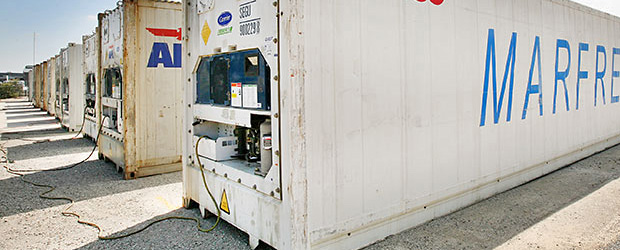September 9, 2015
Reefer Container Maintenance: Do's and Dont's
Regular inspections and proper use, maintenance, and servicing are essential to keeping reefer containers in good shape and sound working order.
Pre-Trip Inspections
Pre-trip reefer container inspections and necessary maintenance, modifications, and repairs are required to ensure customers receive safe and clean containers with efficiently functioning temperature-regulated machinery. Pre-trip inspections typically include:
- Cleaning (dirt and odor removal),
- Inside container inspection to ensure it meets food-grade specifications, and
- Machinery checks to ensure proper functioning to industry standards.
The date, time, and inspector’s name are documented on an attached container inspection label.
Use Qualified Technicians Only
Maintenance and control of shipping containers and equipment should be performed only by qualified reefer technicians, boiler makers, welders, and yard-depot controllers. Apprenticeship training programs help ensure there is an ongoing supply of qualified tradespeople.
Any structural repairs must be performed by IICL-qualified persons. Major container modifications such as extensions, cut-downs, or installations of customized refrigeration equipment may be required at mine sites, offshore oil rigs, or rock concerts.
Maintain For Peak Performance
To ensure refrigerated shipping containers operate at peak performance,
- The reefer unit must not be placed in direct sunlight, but rather where it gets adequate air flow (min. of one meter from walls);
- Clean reefer unit coils by hosing or air cleaning them monthly;
- The fins must be properly maintained to ensure maximum performance, efficient power usage, and continued reefer unit operation;
- Circulating fans must be cleaned and maintained to ensure continual internal air circulation;
- Defrost the reefer unit and ice on the evaporator coil by setting it on a defrost cycle at 9-hour intervals; the frozen cargo defrost cycle is 24 hours; the chilled cargo with closed ventilation defrost cycle is 12 hours; the chilled cargo with open ventilation defrost cycle is 6 hours;
- Monitor digital controllers that feed (air temp) control signals to a computer-based controller (fans and unit are adjusted to maintain precise delivery temp);
- Clear and clean automatic humidity control drains;
- The reefer containers’ digital readouts (thermostats, temperature sensors) must be monitored to ensure the unit is operating at the proper temperature (temperature control is critical for optimal quality);
- Turn off the unit before entering and install a plastic strip curtain at the entry to reduce temperature loss;
- Ensure the reefer unit is properly connected to a 32amp, 415v power outlet;
- Do not assume a 20amp outlet is correct (in extreme conditions), and
- Properly load, at correct temperatures, to ensure optimum cargo quality at its destination.
Repairs / Replacement Parts
Repairs and part replacement is part of maintaining the refrigerated unit. Spare parts are competitively priced and generally major brand items are in-stock and available. Reconditioned parts afford additional savings and may also be available for exchange with electronic components, compressors, motors etc.
Contacts Details
- Address: 34 Hunter Rd, Derrimut
VIC 3030, Australia
- Office Phone: 03 8390 6355
-
| After Hours: | | Danny 0408 488 114 |
- Email: info@tritainer.com.au
Optimized by
NetwizardSEO.com.au
